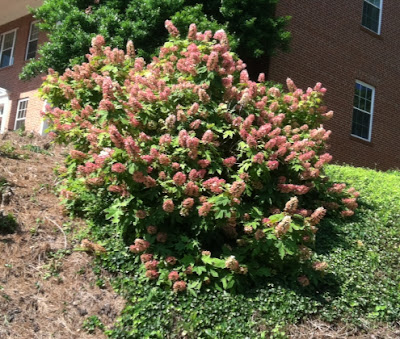 |
| Oakleaf Hydrangea in Late Spring at Callaway Gardens |
I know I've written this many times, but the Oakleaf Hydrangea is my very favorite hydrangea, for several reasons. Hydrangea quercifolia, commonly called the Oakleaf Hydrangea, is beautiful all the time.
In summer, large blooms appear that attract much attention. The panicles of white blooms appear in May. These creamy white blooms can be quite large, depending on the cultivar. Blooms on 'Alice' can be up to 12 inches long, which makes for a spectacular display.
 |
| Late Summer Blooms at LaGrange College |
By late summer the white blooms change to a rosey purplish pink, hanging on into fall.
In fall, the leaves turn a rich mahogany red, contrasting beautifully with the then dried rosy brown flower stalks used by many in floral arrangements.
 |
| Oakleaf Hydrangea Fall Foliage at Shady Gardens Nursery |
In winter, the branches exhibit lovely cinnamon colored exfoliating bark, and the large flower buds already forming are attractive. In spring, the new leaves are a reddish purple. So you see, Oakleaf Hydrangea is truly beatiful in every season!
Hydrangea quercifolia is much easier to grow than other hydrangeas. The fact that it is native to the southeastern United States is probably the reason for that. It’s accustomed to our summer droughts, making it more drought-tolerant than other hydrangea. It isn’t picky about soil. And Oakleaf Hydrangea can take more sun than most other hydrangeas.
Oakleaf hydrangea is one of our most beautiful American native shrubs, and should be in every garden.



















